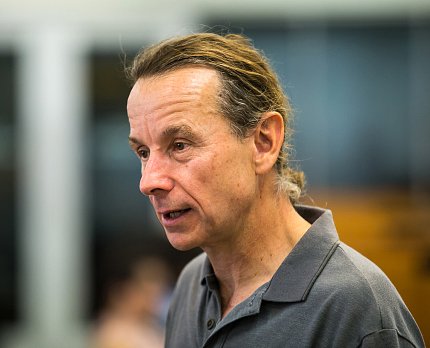Nobel Laureate MacKinnon Opens New WALS Season

Photo: Dale Lewis
Ion channels are gnarly, complicated, formidable things—you wouldn’t want to be alone with one in a dark room.
Full of arms, loops and ribbons that can tighten into a cage or open in welcome, they govern each beat of the heart, in addition to being indispensable in myriad ways to all life forms as they channel sodium, potassium and calcium ions across cell membranes so that muscles can twitch, blood can flow and neurons can carry messages.
There may be no better guide to their abstruse world than Dr. Roderick MacKinnon, who shared the Nobel Prize in chemistry in 2003 with Dr. Peter Agre “for discoveries concerning channels in cell membranes.” MacKinnon gave the opening talk Sept. 27 in the 2017-2018 Wednesday Afternoon Lecture Series.
MacKinnon, who is John D. Rockefeller Jr. professor at Rockefeller University and a Howard Hughes Medical Institute investigator, divulges in his Nobel Prize biographical essay that he is slightly built and once pursued gymnastics in high school. He is also courageous—he set aside his M.D. to pursue what at the time seemed an impossible challenge: determining the structure of the potassium ion channel, which he achieved in 1998 at age 42.
Relentlessly curious since childhood—his dad once chided him for being “a compendium of useless information” (which only served to acquaint him with a new word, compendium)—MacKinnon has pursued basic research ever since a few years after graduating from Tufts University Medical School in 1982.

Photo: Dale Lewis
On a Masur Auditorium stage lit primarily so the audience could see the person at the lectern, MacKinnon roved restlessly to the stage lip, going in and out of darkness to bring back insights from decades of work.
“I consider myself a parasite of great technological methods that others have made,” he began. “It’s great to be in a world where we can pursue science with so much at our hands.”
Ion channels are part welcome mat, part sentry, operating in a binary fashion similar to the computer, ones and zeroes, on and off.
There are at least 80 potassium ion channels in humans, MacKinnon noted. “Different channels have evolved to sense different environmental forces.”
These forces can be chemical, mechanical and electrical.
“They are a very broad and diverse family,” he said. All share a selectivity filter, which makes them kin.
MacKinnon mentioned that he gets insights while paddling with friends. Visit some of the channels he has explored at https://videocast.nih.gov/summary.asp?Live=26429&bhcp=1.
The full WALS series may be previewed at https://oir.nih.gov/wals.—Rich McManus
